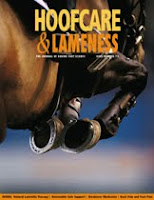A few weeks ago, we introduced a new DVD on this blog. "Recognizing the Horse in Pain" is an interesting survey of subtle lameness problems in performance horses by Dr Joanna Robson, a veterinarian in the Bay Area of Northern California.
In this little clip, you will see a few out-takes from the section on thermography from the video. The Arabian ex-endurance horse was worked up at farrier Mike DeLeonardo's clinic in Salinas, California; his diagnostic protocol included scanning his feet with a thermographic camera, as well as radiographs.
After reviewing all the images with Dr. Robson, Mike was able to come up with a change in the horse's shoeing that would make her much more comfortable.
Dr. Robson's DVD "Recognizing the Horse in Pain" has been very popular and we will soon have the book that goes with it. If you'd like to order the DVD, it is $60 plus $5 post in the USA and $8 post to other countries. However, the DVD is only available in NTSC (North American) format which may not play in some DVD players in other countries. Click here to go the web page for the book or use the PayPal button to order directly.
 © Fran Jurga and Hoofcare Publishing. No use without permission. You only need to ask. Fran Jurga's Hoof Blog is a between-issues news service for subscribers to Hoofcare and Lameness Journal. This blog may be read online at the blog page, checked via RSS feed, or received via a digest-type email (requires signup in box at top right of blog page). To subscribe to Hoofcare and Lameness (the journal), please visit the main site, www.hoofcare.com, where many educational products and media related to equine lameness and hoof science can be found. Questions or problems with this blog? Send email to blog@hoofcare.com.
© Fran Jurga and Hoofcare Publishing. No use without permission. You only need to ask. Fran Jurga's Hoof Blog is a between-issues news service for subscribers to Hoofcare and Lameness Journal. This blog may be read online at the blog page, checked via RSS feed, or received via a digest-type email (requires signup in box at top right of blog page). To subscribe to Hoofcare and Lameness (the journal), please visit the main site, www.hoofcare.com, where many educational products and media related to equine lameness and hoof science can be found. Questions or problems with this blog? Send email to blog@hoofcare.com.














